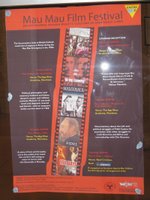Mau Mau Film Festival

In conjunction with the Kenya Human Rights Commission, Aga Khan Academy hosted the inaugural series of human rights consisting of dialogues, debates as well as films. The four films included, In my country (south Africa), Malcolm X – A documentary (US), Fidel (Cuba), and 100 Days (Rwanda). They were extremely powerful and graphic illustrating the struggles for independence and preserving human rights.
The following information, from the BBC, describes the journey of Kenyan independence and why the series is refereed to as Mau Mau.
Kenya, during the 1950's, was dominated by the Mau Mau uprising against the British. A central feature of this revolt was a desire on the part of the Kikuyu, along with some Embu and Meru people, for land taken by the Europeans.The Mau Mau uprising also marked a turning point in the struggle for independence. Kikuyu resistance to European colonisation was well established before the Second World War. The Kikuyu Central Association was active in the 1930's under Jomo Kenyatta who campaigned energetically for the Kikuyu in Europe.In 1951, Kenyatta was arrested and imprisoned by the British for being a leading light in the Mau Mau movement. With his detention Mau Mau expanded.In October 1952, the British declared a state of emergency, which continued until 1960. The State of Emergency was in response to an increase in attacks on the property and persons of white settlers, as well as African chiefs who were seen as collaborators.
A far larger amount, about 13,000, were killed fighting the British, and a further 80,000 were kept in detention camps. The number of Europeans who died in the course of the emergency totalled just 32. The number of original Mau Mau fighters was hugely increased by Kikuyu squatters who were expelled from European land after 1952.The main military leaders were Dedan Kimathi and Warihu Itote, also known as General China. Dedan Kimathi was captured and executed in 1956. General China was eventually released.Kenyatta was not released until 1961. The Kenyan African National Union (KANU) had voted him their President while he was still in prison.The other main party to emerge in the run up to independence was the Kenyan African Democratic Union KADU. In the event, KANU gained a majority in the Legislative Assembly and Jomo Kenyatta led Kenya to independence in December 1963.



0 Comments:
Post a Comment
<< Home